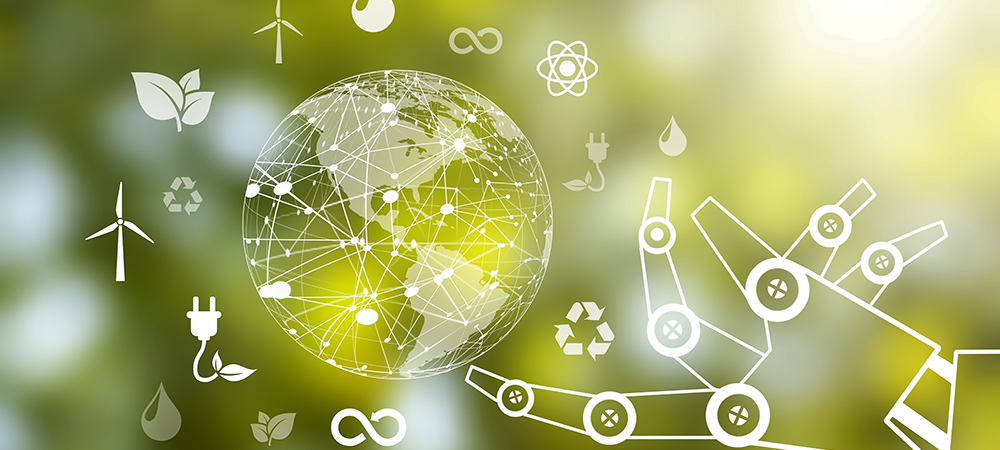Jim Chappell, Global Director of AI at AVEVA, tells us how Artificial Intelligence is becoming a pivotal force in bridging the gap between economic growth and environmental sustainability.

The pursuit of profits is no longer at odds with environmental sustainability. Artificial Intelligence (AI) is rapidly closing the gap between the two, accelerating the scale and pace of the necessary sustainability solutions to address the worsening climate crisis.
AI is increasingly playing a vital role in the world’s transition to greener operations. In fact, about 87% of industrial leaders see AI as a useful tool in the fight against climate change, according to a recent BCG survey. Approximately 43% plan to leverage the science in their own efforts against climate change.
AI technologies are already supporting companies on the path to achieving their net-zero emissions goals. AI is already helping to decarbonize hard-to-reduce sectors. While generative AI has dominated the headlines recently, industries are also incorporating other types of AI technologies in different ways. They are using it to integrate new sources of renewable energy into production lines, drive greater productivity and efficiency, leverage new insights to make better decisions and build more agile and resilient operations.
What AI technologies are used in the industry today?
Let’s take a look at just four main AI technologies that are used across the industrial spectrum today.
- AI-driven predictive analysis can help companies anticipate demand, optimize supply chains, forecast anomalies in assets and optimize inventory levels in real time. By using statistical algorithms and Machine Learning technologies, current and historical data can be analyzed to predict future events, including forecasting overall GHG emissions. As a result, costs and resource usage are reduced, which in turn decreases the environmental impact of overproduction and unnecessary resource consumption.
- The next step is predictive asset optimization. Here, dynamic simulation tools, combined with predictive analysis and advanced visualization, create a hybrid digital twin. Users gain a true 360-degree view of operational risks and can identify and solve problems earlier, as well as forecast the remaining useful life of assets to maximize uptime, availability and profitability. When incorporated into the design of future assets, these insights trigger a cycle of continuous improvement. In real terms, predictive asset optimization accurately forecasts performance degradation and greenhouse gas emissions in depth at a granular level.
- Generative AI is perhaps the most well-known way people encounter AI, both in their daily lives and in industrial applications. The technology has existed for over half a century, but it has now come into its own as massive large language models (LLMs) are available to the public. They enable operators to quickly make sense of large sets of knowledge, or serve as creative partners to support innovation, for example, simulating asset design options according to specific parameters or creating engaging technical learning material. When used in conjunction with real-time data leveraging specialized software, it can also provide deeper insight into data, including assistance in the complex analysis of sustainability issues.
- Gray-box modeling, one of the most advanced industrial AI technologies, has just hit the market. This combination of first principles simulation and AI (white box and black box models respectively) offers the best of both worlds: modeling assets and processes almost in real time to improve system design and also get the most out of operational performance. One of the ways it works is by allowing AI models to integrate with traditional physics-based simulation through a drag-and-drop user interface. AI often runs faster than physics-based models and requires fewer adjustments to set up. As a result, companies can get models up and running quickly, while using less CPU capacity and therefore requiring a smaller carbon footprint.
What benefits does AI bring to industries?
Industrial AI solutions contextualize key performance and sustainability data with Artificial Intelligence and human knowledge. As a result, companies can unlock value and sustainability gains in many ways, now and in the future.
In the energy sector, AI technologies are supporting the transition to renewable energies. The Italian multinational Enel has committed to decarbonizing its energy mix by 2040. It has already installed over 50 GW of renewable capacity. To accelerate the transition, Enel has deployed AI-based asset performance management software along with predictive analytics. Data silos have been eliminated, accelerating decision-making and offering efficiencies across the business ecosystem. The energy leader can now predict asset failures and ensure a constant energy supply, and is on track to achieve a fully autonomous plant.
Similarly, another global energy company is using predictive asset optimization to improve reliability and reduce maintenance costs. Just one capture helped detect a performance anomaly in the heat recovery pipes of a cogeneration unit five months in advance, saving significant costs. Since 2019, the software has detected over 1,700 asset performance anomalies. More than US$37 million has been saved, unplanned downtime has been reduced, and resource usage has been reduced, improving the environmental impact.
AI is generating similar benefits in other hard-to-reduce sectors, such as cement, which generates 6% of all man-made emissions. Oyak Cement, whose operations extend from Turkey to Portugal, Cape Breton and West Africa, uses an edge-to-cloud data management system infused with AI to replace 30% of its energy from fossil fuels with renewable sources, as well as to reduce energy use. For every 1% reduction in energy used, the company saves between five and seven million euros. With real-time information at hand, it also reduces CO2 emissions, ensuring regulatory compliance.
On a more fundamental level, AI is helping increase resilience to the worst effects of climate change. With rising global temperatures, the city of Salem, Oregon, in the Pacific Northwest, has witnessed more outbreaks of toxic algal blooms in lakes and catchment rivers. With the help of a native cloud and multi-tenant data management platform, city authorities have aggregated multiple data sources, from algae levels to water depth and weather and satellite data, into a central hub. Intelligent predictive insights now alert them to increased algae and cyanotoxin activity two weeks before they occur, allowing teams to preserve water quality, safeguard ecosystems, and ensure that Salem’s five million residents have safe drinking water.
Industrial AI is essential for the transition to sustainability
The industrial world is now entering what has been called an AI revolution.
Viewing AI simply as a tool to increase profits is to severely underestimate – and underutilize – the capabilities of this powerful science. As industrial companies work to integrate sustainability into the core of their operations, AI can empower them to align business success with environmental responsibility.
AI will not solve the climate crisis, but it can generate greater value for industries while improving sustainability, although success in each case requires time and effort and depends on how technologies are applied.
However, in general, the union of sustainability and profitability is no longer a difficult goal to achieve. With its capabilities to optimize processes, improve efficiency, and promote green practices, AI serves as a binding element that brings these seemingly separate goals together to create the future we need.
Click below to share this article

